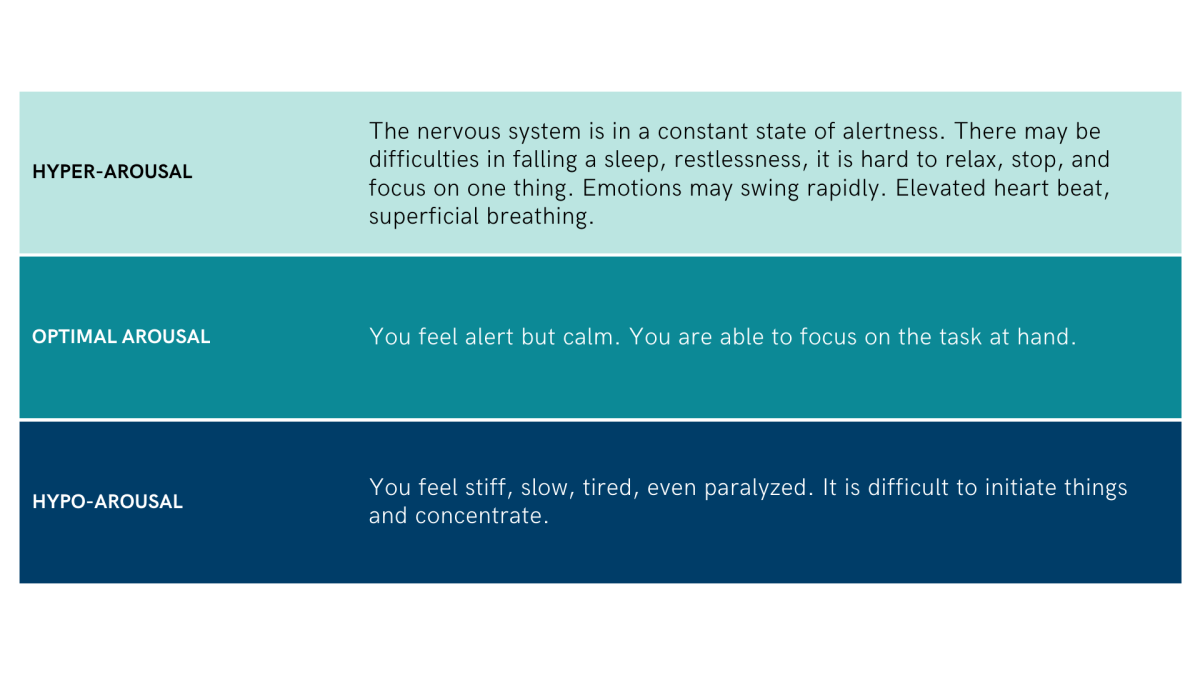3rd week: regulating severe anxiety
Great, you have now reached the halfway point of this self-care programme. Before moving on to this week’s subject, take a moment to return to the previous week’s exercises. You can check in the monitoring form how much you practised last week.
If you have not yet managed to start practising, you can take a moment to think about what has prevented you from practising. Sometimes, your life situation can make it difficult to find time for learning new things, or you may have set goals that are too high for yourself. In such a case, you should look at your use of time and set the bar so low that reaching your goals is ridiculously easy.
Previous week’s exercises
How many times did you practise
– bottle blowing
– pursed lip breathing
– lengthening your exhalation?
What other exercises and things did you do over the past week to regulate your anxiety or take care of your wellbeing in general?
Return to the ‘Intensity of anxiety and selection of methods’ form. In what kind of an emotional state could the exercises help you?
Which exercise are you planning to continue doing? How well do you find it to alleviate your anxiety symptoms or maintain your wellbeing?
Continuing breathing exercises
The previous week, you practised bottle blowing and pursed lip breathing. In this week’s breathing exercise, we will combine pursed lip breathing with motion and using your vision. For the exercise, you will need a peaceful space in which you can do the exercise for roughly five minutes.
Finger breathing 1
Contemplate: What kind of changes do you notice in how you feel and your body after the exercise? What kind of anxiety could you regulate with this exercise?
Anxiety and alertness
Fluctuations in alertness are associated with anxiety. When a person is in an optimal state of alertness, they are within their window of tolerance, so to speak. In that state, it is easy to be social, playful and creative. Stress can cause the person’s state of alertness to increase beyond the window of tolerance into hyper-arousal. Stress boosts our activity and can thus be useful in reasonable doses. The increased alertness brought about by stress can manifest itself as physical restlessness, difficulties with keeping still, an elevated heart rate and difficulties with falling asleep. Some people experience increasing anxiety as their level of alertness increases.
Usually, the body and the mind return from hyper-arousal to the window of tolerance spontaneously. Sometimes, long-running stress can cause a persistent state of hyper-arousal, resulting in issues such as sleep difficulties, anxiety and physical symptoms. This can also be caused by an underlying innate or trauma-based sensitivity to neural activation.
When stress continues for a long time without sufficient recovery or when the person perceives a threat as extreme, their level of alertness can drop down into hypo-arousal. In the animal world, prey animals freeze or go into suspended animation in situations in which they are unable to flee their predator. This state can fool the predator, but is also a way to alleviate physical pain. People can also use freezing as an extreme survival mechanism. Events such as traumatic experiences often involve dissociation, whereby the person’s mind “exits” and they may feel like they are outside their own body, for example. Long-running hypo-arousal is often associated with depression.

You can influence your state of alertness
We can learn to influence how quick we are to become hyper or hypo-aroused, as well as how well we are able to return to our window of tolerance, through conscious practice. One important step in the regulation of alertness is strengthening our self-knowledge. This involves the ability to identify how easily our alertness fluctuates, what are our own signs of hyper and hypo-arousal, and what things can cause our alertness to increase or decrease. Accordingly, this self-care programme focuses on our own anxiety symptoms and sources right at the beginning. Another way to increase self-knowledge is to increase our body awareness, which we will tackle next week.
Last week, we examined the connection between breathing and anxiety. We can regulate our breathing to affect both hyper and hypo-arousal. When we are feeling hyper-aroused, we can calm both our body and our mind by lengthening our exhalation. Long exhales activate the parasympathetic nervous system by sending a message that there is no threat. We can tackle hypo-arousal the opposite way; by lengthening our inhalation. Long inhales are connected to the operation of the sympathetic nervous system (cf. excessive breathing).
Try this: Do the finger exercise above for a moment. How does it affect your alertness? Next, do the finger exercise in an opposite way: inhale while drawing an S figure upwards, and then bring your finger straight down when exhaling. How does this affect your alertness?
Sometimes, the anxiety brought about by hyper or hypo-arousal is so intense that regulating your breathing is not enough. Below are various physical exercises and eye movement exercises that can help you regulate severe and extreme anxiety. Combining different methods is also often called for when you are experiencing particularly severe anxiety. When you are outside your window of tolerance, it is important that you not only utilise these methods and breathing regulation, but also increase your sense of security through suitable means, learn to ease up and seek to connect with people important to you and your environment.
Anxiety increases activation in the nervous system. The sympathetic nervous system becomes active and adrenaline is released in the body. The purpose of adrenaline is to prompt the person to act. It makes the person feel restless and focus on the thing that is increasing their alertness – in this case, the source of anxiety, whether it be a thought, a sensation, a situation or a feeling in the body.
You can utilise intense physical methods when you want to shift your focus from anxiety-inducing thoughts to the present moment and enable your body to discharge your restlessness. In the video below, physiotherapist Sari Lamio talks about how intense physical exercises can help with anxiety regulation.
How to reduce severe anxiety and breaking of thought patterns
Any intense physical activity can help with anxiety. When we are physically active, we utilise our adrenaline. The more intense the exercise, the more sure it is to shift our focus to the present moment and our muscular sensations.
Two things you should never do (when experiencing intense anxiety). Number one, never just passively wait for the attack to pass. Keep moving. — Number two, keep your eyes open and stay in this world.
Sari Lamio, physiotherapist
The videos below present four good alternatives. You can do these exercises without jumping and relatively quietly, making them joint-friendly and possible to do at your workplace or study place, for example.
Calf pump
Wall sit
Wall push
Plank
Contemplate: What kind of changes do you notice in how you are feeling and your body after these exercises? What kind of anxiety could you regulate with these exercises?
Try this: In addition to the exercises above, you can try stair running, jumping jacks, dancing or push-ups! The important thing is that you have various intense exercises planned and practise them when you are feeling good so that you can think of them when feeling severe anxiety.
In addition to helping with anxiety regulation in the moment, intense physical exercises are good for your health in the long run, which can also have a positive effect on your anxiety sensitivity.
When you are experiencing extreme anxiety, your body may freeze. This means that your alertness drops down to hypo-arousal. Prey animals exhibit the same reaction in nature: when the situation is so threatening that there is no use fighting or fleeing, the safest and most painless reaction is to go into suspended animation. This freezing is a survival reaction relevant to humans as well when faced with an extremely difficult situation.
When you are experiencing anxiety, freezing does not always require a life-threatening situation. For example, some situations may have become unbearably frightening in your mind due to previous experiences.
Mild hypo-arousal can feel like tiredness, for example. At its most extreme, hypo-arousal can become a dissociative state in which the mind is no longer present in the moment and the person may feel very detached from their body. Dissociative symptoms are often based on traumatic experiences.
If your anxiety becomes so extreme that you freeze, eye movement exercises can help you get moving again. Noticing that you can move – even if only through eye movement – can help you expand that movement into other parts of your body.
Eye movement exercises
Contemplate: How did the eye movement exercises feel? Did they affect how you are feeling? What kind of anxiety could you regulate with these exercises?
Alleviating highly intense exercises is like walking down a flight of stairs: you take one step with one method and another step with another method. The most intense symptoms call for intense methods that can help you take the edge off the feeling – this often means using a strong physical exercise.
When you are experiencing extreme anxiety, it is difficult to start thinking about what could help. You may feel like nothing will help or simply become unable to think. Because of this, it is essential that you try the methods beforehand, make note of which methods are useful to you and make sure that when push comes to shove, you will have something to remind you to use these methods.
The idea is not for you to learn methods that will help you avoid anxiety or eliminate it altogether. The way you should look at these psychophysical exercises is that they can help you cope with situations that would otherwise be unbearable and regulate your anxiety in ways that do not cause harm to yourself. The exercises can make you feel better and enable you to do things that are important to you.
Try this: You can regulate severe anxiety effectively by combining several exercises. Start doing a physically intense exercise, such as sitting against a wall, and keep doing it for a few minutes. When you notice a change in how you are feeling, move on to finger breathing in which you lift your finger straight up while inhaling and drawing a curvy line downwards while exhaling.
If you have a tendency to freeze, try starting with an eye movement exercise and moving on to finger breathing in which you lift your finger up in a curvy line while inhaling and quickly move it down while exhaling.
Exercises for the week
We hope that this week’s section has provided you with tools for regulating severe anxiety. In the coming week, reserve some time for doing this week’s exercises every day and record them in the monitoring form:
- Finger breathing
- Intense physical exercises: calf pump, sitting against a wall, pushing the wall, plank, etc.
- Eye movement exercises: drawing an X and a lying figure eight
- Combining exercises
